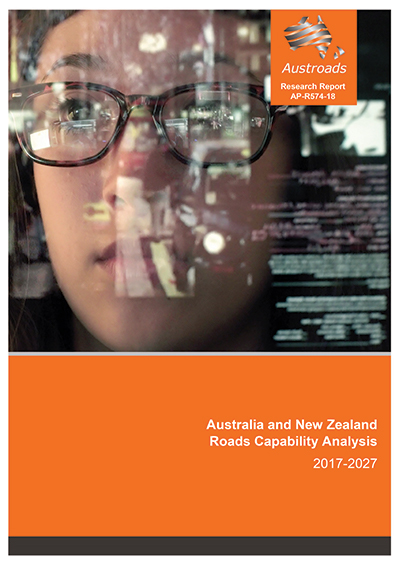Agency Management

- Publication no: AP-R574-18
- ISBN: 978-1-925671-65-0
- Published: 19 July 2018
- PDF (free) Download
This is the Final Report of the Australia and New Zealand Roads Capability Analysis 2017-2027. This report combines recent quantitative (workforce gap) and qualitative analysis (industry consultation) undertaken for this study to explain how ‘traditional’ and ‘non-traditional’ skills demand will form for roads agencies over the coming decade, what will be the key threats to workforce capability in the roads sector, and what positive steps roads agencies can take to respond to meet the short and longer term challenges ahead to 2037.
In defining the skills considered here, use was made of the ‘skills cluster’ framework developed by Foundation for Young Australians (FYA), where ‘traditional’ road agency skills are defined as those skills come from artisan and designer clusters and ‘non-traditional’ skills come from informer and technologist clusters. Through this, and extensive stakeholder and industry engagement, this workforce capability analysis has a much broader scope than previous analyses and presents a richer tapestry of capability threats and potential solutions for consideration by road agencies in Australia and New Zealand.
- Summary
- 1. Introduction
- 1.1 Structure of this Report
- 2. Methodology
- 2.1 Introduction
- 2.1.1 Industry Liaison
- 2.1.2 Industry Survey
- 2.1.3 Quantitative Analysis
- 2.2 Defining the Roads Sector
- 2.3 Defining the Roads Workforce Capability Skill Sets
- 2.1 Introduction
- 3. Review of Existing Literature
- 3.1 Previous Austroads Analyses by BIS Shrapnel
- 3.2 Transport Systems Catapult (2016), Intelligent Mobility Skills Strategy
- 3.3 Highways UK (2017), Highways skills shortage: the ticking time bomb
- 3.4 Infrastructure NSW (2017), NSW Construction Delivery Assessment
- 3.5 Transport & Logistics IRC (latest edition 2017), Skills Forecast
- 3.6 Literature Review: Summary of Findings
- 4. Current State of Play
- 4.1 Economic Trends and Outlook
- 4.1.1 New Zealand
- 4.1.2 Australia
- 4.2 Construction Industry: Trends and Outlook
- 4.2.1 New Zealand Construction
- 4.2.2 Australia Construction
- 4.3 Roads Industry: Trends and Outlook
- 4.3.1 New Zealand
- 4.3.2 Australia
- 4.1 Economic Trends and Outlook
- 5. Quantitative Modelling Results
- 5.1 Introduction and Methodology
- 5.1.1 Demand, Supply and the Workforce Gap
- 5.1.2 Defining the Roads Sector
- 5.1.3 Estimated Roads Workforce
- 5.1.4 Forecasting future skilled labour demand
- 5.1.5 Usage Coefficients
- 5.1.6 Modelling Workforce Attrition
- 5.1.7 Modelling New Graduate Supply
- 5.1.8 The Capability Deficit or Surplus
- 5.1.9 Scenario Analysis
- 5.1.10 Limitations of the Model
- 5.2 Modelling Results under Baseline Scenario
- 5.2.1 Australian workforce projections
- 5.2.2 New Zealand workforce projections
- 5.3 Modelling Results under Alternative Scenarios
- 5.4 Workforce Capability Outlook
- 5.4.1 Workforce demand outlook to 2027
- 5.4.2 Workforce supply outlook to 2027
- 5.1 Introduction and Methodology
- 6. Roads Workforce Capability – Industry Perspectives and Challenges
- 6.1 Industry Survey Outcomes
- 6.1.1 Survey methodology
- 6.1.2 Level of difficulty in recruiting staff – the ‘Here and Now’
- 6.1.3 Occupations likely to see skills shortages in the future
- 6.1.4 Key Risks to Workforce Capability
- 6.1.5 Key Risks to Workforce Capability from Technological Change
- 6.2 Insights from Industry Interviews
- 6.2.1 Perceived current and future role of roads agencies
- 6.2.2 Existing capability concerns
- 6.2.3 Future skill sets and capabilities
- 6.2.4 Impact of new technologies
- 6.2.5 Other risks to workforce capability
- 6.3 Summary of Results From Industry Consultation
- 6.1 Industry Survey Outcomes
- 7. Ensuring Workforce Capability: A Road Map
- 7.1 Challenges and potential solutions
- 7.1.1 Meeting ‘traditional’ skills challenges
- 7.1.2 Meeting ‘non-traditional’ skills challenges
- 7.2 Recommendations
- 7.1 Challenges and potential solutions
- References
- Appendix A ANZSCO Occupation Classification
- Appendix B Base Case Modelling Results
- Appendix C Industry and Roads Agency Survey
